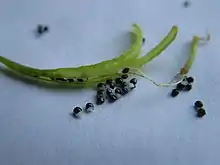elaiosome
English

Corydalis cheilanthifolia (fern-leaved corydalis) pod and seeds with whitish elaiosomes
Etymology
Ancient Greek ἔλαιον (élaion, “olive oil”) + σόμα (sóma, “body”).
Noun
elaiosome (plural elaiosomes)
- (botany) A fleshy structure rich in lipids attached to the seeds of many plant species, usually to attract ants that disperse the seeds.
- 1999, Karen van Rheede van Oudtshoorn, Margaretha W. van Rooyen, Dispersal Biology of Desert Plants, Springer, page 17,
- Ants collect the diaspores for the edible elaiosome, carry them to their nests and consume the elaiosomes. Sometimes, the elaiosome content is sucked from the diaspores, or the elaiosome is loosened on the way to the nest.
- 2003, Elena Gorb, Stanislav S. N. Gorb, Seed Dispersal by Ants in a Deciduous Forest Ecosystem: Mechanisms, Strategies, Adaptations, Kluwer Academic Publications, page 44,
- Experiments with removal of C.[Corydalis] cava seeds with elaiosomes ablated, and with paper balls, infiltrated with juices of seed bodies and elaiosomes, showed the crucial role of elaiosome content in the ant attraction.
- 2007, Victor Rico-Gray, Paulo S. Oliveira, The Ecology and Evolution of Ant-Plant Interactions, University of Chicago Press, page 47,
- Elaiosomes also vary in size, and ants in many instances preferentially disperse diaspores with the greatest elaiosome/diaspore mass ratio, although plants produce seeds of different sizes, allowing for a variety of ants to effect their dispersal
- 1999, Karen van Rheede van Oudtshoorn, Margaretha W. van Rooyen, Dispersal Biology of Desert Plants, Springer, page 17,
Hyponyms
Translations
fleshy structure
|
See also
This article is issued from Wiktionary. The text is licensed under Creative Commons - Attribution - Sharealike. Additional terms may apply for the media files.